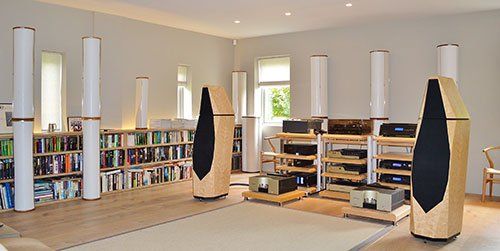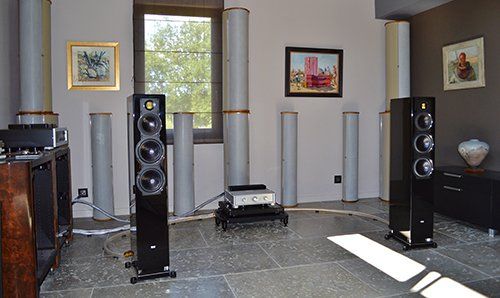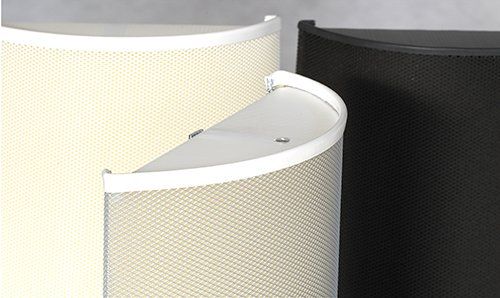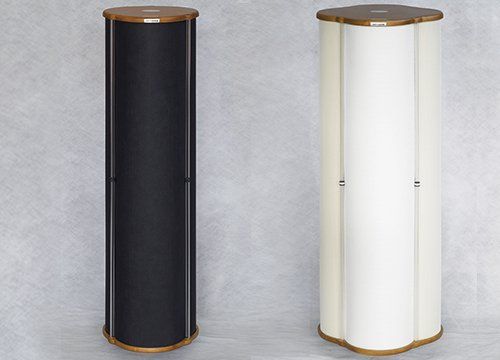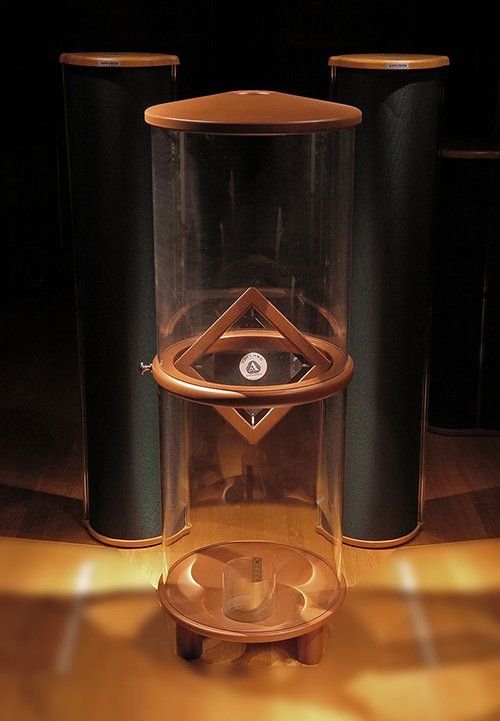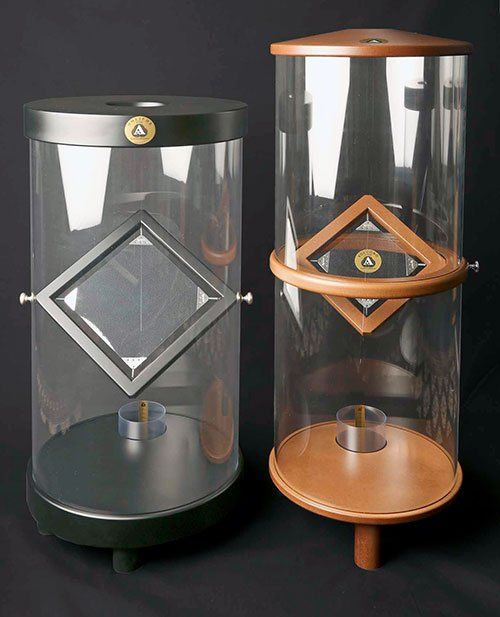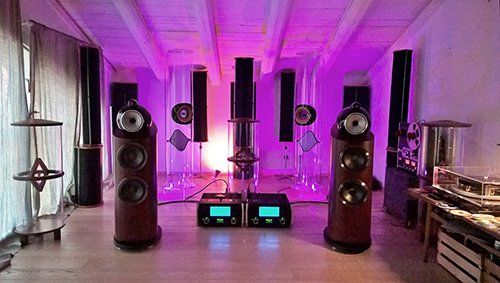Room Acoustics Treatments
It is estimated that up to 60-70% of audio distortions come from excessive bass and reflections within the listening room. The other 30-40% of distortions are from unwanted resonances within the equipment or from acoustic feedback - structural and airborne. Reducing either of these distortions by at least half will result in a significantly better sound.
Having tried many products over the years, we know that those illustrated below really work. Many other products are on the market but are not all equal in their effect on sound. All will make a difference to the sound but some can make a bad difference. This is because many are panel applications that absorb the frequencies, not the excess energy created in a room. To a large extent these panel solutions work just on the high and mid range frequencies.
Most room acoustics problems occur from too much bass energy that migrates to the walls and then concentrated in all the corners. The Acustica Applicata products are all designed to control and absorb the lowest bass frequencies as well as extending upward across the mids and high frequencies. Hence they control the room acoustics but they do not over damp. The alternative panel approaches do not attend to the lower frequencies. The result is often one of over-damping and a skewed room frequency response.
Acustica Applicata
Diffusion Absorption Acoustic Devices (DAAD)
It is now accepted that approximately 60-70% of an audio system’s distortions are as a result of excessive bass energy and reflections within your listening room. Therefore treating the room acoustic problems can be a very cost effective upgrade path, often costing less than upgrading electronics or speakers.
Most rooms suffer from too much bass energy which concentrates in corners and nodal points along walls. When this is excessive, it reduces transparency right across the frequency bandwidth and causes smearing of the imaging. Removing or reducing this excess bass energy results in more tuneful, controlled bass frequencies, rhythm and timing is more correct. Transparency, detail, imaging and articulation are all improved.
This Italian manufacturer makes cylindrical pieces called Diffusion Absorption Acoustic Devices, DAAD. As the acronym suggests, these room tuning products offer a unique combination of absorption and diffusion capabilities. Their principal function is to absorb and remove excessive levels of bass energy. They do not remove specific frequencies that other competitive devices do which skews the tonal balance without dealing with the main problem, bass energy concentration.
Most traditional acoustic treatment devices, usually panels fixed to the wall in a haphazard fashion, tend to absorb the medium and high frequencies without any effective reduction of the lower frequencies. This tends to skew the frequency response and does not deal with sound pressure build up.
These alternative systems, are usually reliant on foam, multi-fibre, or fabric based treatments, principally absorbing the highs and mids most without much consideration for the real problem, excess bass energy. This results in over-damping, loss of speed and dynamics – so the sound all ends up being a bit “dull”. The reason the DAADs work better is that they tackle sound pressure issues rather removing actual frequencies, therefore they do not overdamp.
DAADs absorb excess energy, broadband. They start operating well down in the bass frequencies ranges where most rooms have problems, but their effect extends up to 20kHz. This results in a larger sound stage within which it easy to discern the spatial details and clues required to create a truly holographic experience. They also improve tonal balance resulting in a much less bright or forward presentations giving a more natural sound, without loss of dynamics or rhythmic qualities.
They are also extremely effective when placed at first reflection points in a room ameliorating poor articulation. Uniquely, there is also a lobe that diffuses some of the sound, reflecting some higher and mid-band frequency energy back into the room. When placed at strategic reflection points in rooms, the angle of this diffusion side can be used to ‘shape’ the sound stage and the focus the imaging to taste.
They are also very light. Hence they can be placed in position for critical listening sessions and removed when not required. If you move house – or change rooms – they go with you and never become redundant.
DAADs are all in place and are set up as you suggested, and to say I am pleased would be an understatement. Probably one of the best purchases I have made, and one which I should have done years ago if I had known or realised how important room acoustics are. Anyone serious about their HiFi system, must use room treatments such as DAADs to hear the true potential of what they have.
Mr Stephen Fice, south Wales
We were impressed before we got them for home demonstration – their effect is easy to spot in almost any environment – but it’s in the listening room you know best where the real force of the argument is driven home.
Alan Sircom, Hi-Fi+
All current DAADs are now the Mark II version. This is due to a change of materials used just inside the outer circumference which has improved the performance by approximately 15%. The appearance of the the DAADs remains the same.
The DAAD MK II has a new innovative material developed for other high technology industries such aerospace and electro-medical. The structure of this material has a layered section, the density of which varies from one surface to the opposite surface. The characteristic of this progressive structure fits perfectly with the requirements of a wide-band acoustic trap. Using this new material, the sound pressure wave enters into DAAD volume much more easily, but is released out of DAAD much more slowly. Because the sound pressure is absorbed much more quickly, and held onto for longer, the Mark II version is more efficient.
Listening tests with DAAD Mark II have substantiated the claim. The immediate effect is one of more air and space around instruments and voices. The improved reaction speed of the acoustic treatment to the music pressure pulsation, results in increased dynamics, more accurate phase response, richer low frequencies and texture. The increased transparency and the "blacker" background allows low level details to be more easily perceived, especially at lower volumes.
Due to increased costs of transportation and customs tariffs post Brexit, we have reluctantly had to increase prices.
DAAD 2 MkII 110cm x 20cm; efficient from 120 Hz up to 20 KHz £800 each
DAAD 3 MkII 110cm x 28cm; efficient from 70 Hz up to 20 KHz £1200 each
DAAD 4 MkII 110cm x 40cm; efficient from 50 Hz up to 20 KHz £1450 each
EcoDAAD for ceilings and/or wall applications £340.00
Studio DAAD: a DAAD 2 on a telescopic stand adjustable from 23cm to 110cm from the floor. £1000.
Available in white and black.
Discounts available for orders of 6 pieces or more. 2 EcoDAADs count as 1 piece.
Polifemo (1.85m high with ‘iris’) £7000.
A first stage room treatment plan can be achieved from £2650-3150. For a very marked effect on sound, using 8-10 pieces, the investment will be approximately £4800-6990, dependent on the size of DAADs selected. This more balanced sound, with a larger soundstage and better articulation is more noticeable, and more cost effective, than investing the same, or more, in new electronics, loudspeakers or expensive cables. And the investment stays with you forever.
Home Trial Schemes
To evaluate these products we can offer a short demonstration in our studio facilities to hear their effect on room acoustics. Customers can then borrow a small number of DAADs to try in their own home. Usually we recommend 5-6 pieces minimum for this purpose. Alternatively a home visit can be organised and we would demonstrate and advise on their correct placement in your room. A fee for such home visits applies, covering both consultancy time and travelling expenses. Should an order result, the consultancy element of the fee would be fully redeemable against the purchase. Please phone or email for full details.
How to use them
Generally the first place to treat is the corners of the listening room behind the loudspeakers. There are three types of DAAD; all are 1.1m tall and each type has a different diameter which absorbs across a wide range down to different low frequency points.
It is recommended to have a column of two pieces in each corner. In most of the UK rooms we have found that a DAAD 3 on top of a DAAD 4 in each corner that produces the best results. In the case of small rooms, stand mount monitor type loudspeakers, or electrostatics where high levels of bass energy are not being produced, a column of two DAAD 3s is usually sufficient.
The DAADs in the corners behind the loudspeakers can be rotated whilst listening carefully with a favourite recording, to give the best focus of imaging, the type of soundstage presentation and energy levels desired.
The next stage, if this is possible, is to place a column of DAAD No.3s in the centre of the wall behind the loudspeakers. The effect on ’cleaning up’ the sound-stage is very obvious and very powerful.
Then the first reflection points are treated on the wall behind the speaker and/or the lateral walls. This can be done with either the economical EcoDAAD, or for better results with either the DAAD 2 or DAAD 3.
The last stage is to treat the corners behind the listening position usually with a column of DAAD 3s and/or DAAD 4s.
The EcoDAAD product is a half round absorber. It is designed to be placed at first reflection points on side walls, front and rear walls or on ceilings. They are very light and can be hung with a small nail and removed when critical listening is not taking place. They are very cost effective and less obtrusive than using a DAAD 2 or DAAD 3 for this purpose. They have a very powerful effect on the depth of stage and the focus of image. A DAAD 2 or 3 would be the optimal suggestion for first reflection points but the EcoDAAD offers a less expensive alternative for this application.
The Volcano and Halifax
Acustica Applicata has developed a new variable resonator product called the
Volcano. It is based on the principle of the successful Polifemo, the narrow band Helmholz resonator, but without the iris. The Volcano is shorter than the Polifemo, about the size of a DAAD 4, and can be applied to a variety of room positions where specific bass energy concentrates. But the principal application is
between the loudspeakers, in the same plane, or just behind them. This position is where complex energy turbulences occur and the Volcano is the first acoustic device ever designed specifically to treat this area.
Additional positions for excellent results are on the boundary walls to the sides of the loudspeakers, or on the wall behind the loudspeakers. See photos on right. They are designed to be used
in addition to, rather than replace,
DAADs, but substitutions can be made with some small compromises in performance.
When used in the recommended position between speakers, the effect on the sound is nothing less than spectacular. The biggest effect of placing a Volcano here is on the soundstage, and this is extremely evident even after just a few minutes listening. Everything is more holographic, and focus of images within the 3-dimensional stage is more precise. Transparency is increased allowing low level detail to be more easily perceived. True fine detail comes through, such as a singer or instrumentalist moving around the microphone. It is more like a person standing there rather than just a voice or saxophone. Tonal balance is more natural and dynamics improved. The overall impression is more like being at a live event.
The reason for this big improvement in sound is due to the large amount of energy turbulence created by the speakers projecting sound in all directions, not just forwards. Just imagine dropping two spheres into a rectangular swimming pool where your speakers are positioned. The waves emanating from this disturbance flow outwards at 360 degrees, and crash into one another creating turbulences. Further turbulences are caused by the waves hitting the sides and reflected back into the pool. A very complex situation of turbulences quickly builds up. And this is one simple wave pattern. Music in a room is much more complex, and multiple frequencies are involved, so energy peaks build up, cancellations occur. It very quickly become extremely chaotic. A more detailed explanation is presented in the link below.
Acustica Applicata are the first room acoustics company to appreciate and understand this energy turbulence problem between loudspeakers. The Volcano is the first product in the world designed specifically to deal with this problem. And deal with it effectively and simply.
A recent trial with one of our customers produced this appraisal from him:
I have to say that this device has made the biggest difference to my system of any I have tried to date, whether cables, valves, plugs, even the DAAD’s themselves. The improvement it brings about is profound and transformative. This has to be the best value improvement it is possible to make to any high level system. Absolutely incredible. Thank you for the opportunity to audition – and to buy - it.
DM Oxfordshire
For those that do not want to use DAADs for aesthetic reasons, the Volcano can be used in corners to good effect but there are some compromises. Similarly the Volcano can also be used on the centre of the wall behind the listening position. By doing so, a Volcano can save the requirement for 2, or even 4, DAADs in such applications, with some compromises.
The Volcano has a fixed port in the top, and a further port in the bottom that is height adjustable to tune it to the bass frequency to be addressed. Inside is a paddle that can be adjusted in angle to improve and tune the higher frequencies.
The standard Volcano comes in two parts that are fitted together easily. No fixing or gluing is required. Where excessive bass energy problems are encountered at lower frequencies, an additional centre piece can be purchased and fitted to increase the height from 102 cm to 144.5 cm. This centre section (42.5 cm high) can be added at the time of purchase, or retro-fitted easily at a later stage.
Standard Volcano: height 105 cm (40"), diameter 40 cm (15"). Effective from 38 Hz. £2100
Standard Volcano finished in matt Anthracite or White. £2300
Additional Centre Module: height 42.5 cm (16.7"), diameter 40 cm (15"). Effective from 25 Hz £700 Additional Centre Module finished in matt Anthracite or White £800
The Halifax is similar in design to the Volcano but is shorter and slightly wider. It is designed principally for use in home cinema systems, hence the reason for its lower height, and is only available in matt anthracite. It is effective from a lower frequency than the standard height Volcano, 28 Hz. There is an adjustable tuning port and internal paddle as with the Volcano. However, it cannot be extended in height.
Our listening tests have found it extremely effective in typical 2 channel stereo systems and the lower height can have less of an impact on the room when placed between loudspeakers. Because it is effective from a lower bass frequency, some customers prefer the sound to that of the standard Volcano.
Due to increased costs of transportation and customs tariffs post Brexit, we have reluctantly had to increase prices.
Halifax: height 88 cm (35"), diameter 42 cm (16.5"). Effective from 28 Hz. £2400
Standard finish matt Anthracite.
Halifax in RAL colours on request £2800

